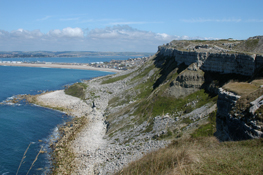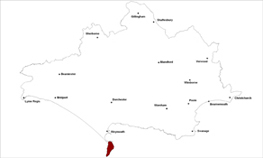Limestone peninsula


Location
The Isle of Portland forms the Limestone Peninsula landscape type.
Key Characteristics
- a dramatic and distinctive wedge shaped limestone peninsula at the end of Chesil Beach with prominent cliffs
- a unique coastal landmark with sweeping views along the coast
- the pale grey Portland limestone rock dominates the natural and built landscape
- exposed, windswept and rocky landscape
- quarrying and military activity has and continues to significantly impact on the islands character
- little tree cover and a historic pattern of small fields separated by low stonewalls
- a disjoined, untidy and neglected feel
- an open skyline dominated by manmade structures and features
- many key nature conservation sites of importance
- Portland Bill and the lighthouse are key landscape features
The Isle of Portland forms a dramatic and distinctive wedge shaped peninsula at the end of Chesil Beach with prominent cliffs all around the Isle. The peninsula slants southwards with the cliffs therefore getting lower towards Portland Bill on the southern tip. It is one of the iconic and unique coastal landmarks in the county, if not country, with extensive sweeping views up and down the coastline and very different to all other parts of Dorset. The pale grey Portland limestone rock dominates the natural and built landscape and is key to and defines the areas cultural and industrial history. Quarrying and military activity has and continues to significantly impact on the islands rocky landscape, underpinning the sense of place for the whole island. The four main dense settlements of Fortuneswell, Easton, Weston and Southwell all have a different feel despite being based on the same local stone. Much of the area is rugged, dispoilt and pitted with old and new quarrying activities, tracks and spoil tips. This together with urban fringe uses such as pony paddocks creates a disjoined, untidy and neglected feel. However there are some key limestone grassland habitats found amongst this landscape of international importance for their nature conservation value and the cliffs and undercliffs are vital in this regard. Tree cover is limited due to the maritime exposure and there is a characteristic and historic pattern of small fields separated by low stonewalls which are often in a poor condition. The lack of trees means the skyline is very open and dominated by manmade structures apart from outward views from the cliffs. Portland Bill and its lighthouse are iconic landscape features at the southern tip of the peninsula. The massive and imposing fort at the Verne is another key feature which dominates the northern end.
Management Objectives
The overall management objective for the Limestone Peninsula Landscape Type should be to maintain the integrity of the skyline, conserve the ancient field patterns, conserve and enhance the biodiversity value and rugged character of the cliff tops and quarried landscapes, promote industrial heritage and a strategic approach to landscape restoration.
Key land management guidance notes
- conserve and enhance local stonewalls particularly around ancient field boundaries
- promote the islands industrial heritage
- conserve and enhance the biodiversity and landscape value of limestone grasslands and in quarry restoration schemes
- tree planting is not a desired management objective in this windswept coastal landscape
- prevention of spread of non-indigenous scrub like cotoneaster is a priority, while rotational scrub management of native species is desirable
- promote existing and future grazing initiatives as a way of controlling scrub and increasing biodiversity interest
- maintain the sensitive skyline from inappropriate development by ensuring any new development is sited off the skyline when viewed from key locations such rights of way
- conserve and enhance the rugged and rocky character of Portland by limiting the desire to ‘tidy up’ the landscape
- manage and control the impact of quarry spoil heaps and industrial buildings, in particular by controlling their heights, profiles and colour
- maintain the open character of the cliff tops e.g. by limiting the amount size and position of development and by considered zoning and/or identifying key cliff top character area
- encourage and promote a strategic approach to landscape restoration e.g. to link up future open spaces and/or habitats
